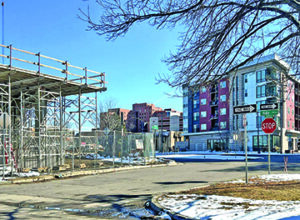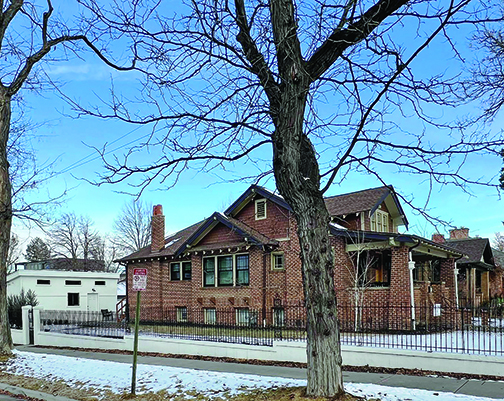by Heather Brecl

Overdevelopment: Neighbors argue that Hale neighborhood is already stressed by overdevelopment and apartments and does not need more ADUs.

Back To The Future: Denver City Council eliminated Accessory Dwelling Units in 1954. They have raised their ugly head again as seen here at a home in Washington Park.
As the real estate market heats up this Spring, residents in Denver’s Hale neighborhood fear that new proposed rezoning laws regarding ADUs (Accessory Dwelling Units) will further accelerate unwelcome change in the neighborhood they love. And the concerns don’t stop with those residing in Hale — their neighbors in Mayfair, Hilltop, and Crestmoor Park see the impending loosening of regulations as the opening of floodgates for a myriad of problems that will devalue the historic neighborhoods that they hold near and dear to their hearts.
ADUs are a secondary structure or apartment that shares the lot with a larger primary home. They are built to provide additional and separate space for extended family members or to create income as a rental to offset mortgage costs. Often, they are apartments built above a garage, but can also include a finished basement used as separate living quarters. According to the City and County of Denver, Denver Zoning Code no longer has minimum lot size requirements for ADUs, though the size of the property does affect the size of a detached ADU and where on the property it can be.
Controversial District 5 Denver City Councilwoman Amanda Sawyer, a former California resident and CU Boulder grad, (serving Cherry Creek, Country Club, Hale, Hilltop, Lowry, Montclair, Washington-Virginia Vale, and Mayfair) is sponsoring the ADU rezoning efforts. Sawyer is already in hot water with her District 5 constituents over so-called traffic calming measures at 7th and Williams, and other locations which are causing traffic accidents (see Chronicle October 2023 edition’s front page “7th and Williams Fiasco”), and even a recent fatality. Sawyer believes that making ADUs easier to build in Hale will answer some of the affordability challenges that Denver buyers face.

Proposed Rezoning: The areas highlighted in yellow and orange indicate lots subject to ADU redevelopment.
Members of the community in and around Hale see the addition of ADUs through a much different lens. According to residents in the surrounding neighborhoods, making ADUs a more accessible option for all homeowners in the area will destroy the character of their neighborhood and create irreparable damage in addition to the growing pains that are already facing. They fear that ADUs will be used as rentals to offset housing costs, creating a flood of trouble. With the slew of retail, restaurant, and entertainment venues that have been built in the Hale neighborhood near 8th and Colorado in the past few years, along with thousands of new residents that moved into the 9th+CO development, parking and congestion of traffic is already extremely formidable.
One Hale resident, who was granted anonymity to speak freely, has experienced first-hand the nightmare of having to find parking every night by her condo at 11th and Hale, even though she

In Hot Water Again: Councilwoman Amanda Sawyer has stirred controversy once again by pushing the development of ADUs in the Hale neighborhood. Residents of other neighborhoods fear this is just the beginning of pernicious overdevelopment.
owns her own spot. The resident’s designated parking space is rarely available for her own use — recently she parked three blocks away and was robbed at gunpoint returning home from her car. With the congestion and overdevelopment comes a new nine-acre development site with housing that is going in where the old VA Hospital is. Residents have pointed out that there are multiple empty lots where development has stalled, and they have witnessed growing numbers of homeless people.
Many residents believe that the rezoning in Hale isn’t even needed in the neighborhood as there are enough vacant rentals available already. Many feel that most residents probably can’t afford to get a permit for an ADU let alone build it, so there is no reason to change the existing law for the ones who can. They propose that the passing of the measure is simply intended to create a snowball effect for Mayfair and Hilltop next. Of the 16,401 occupied housing units in Hale, 56.81% are owner-occupied, while 43.19% have renters living in them. (Source: point2homes.com). Councilwoman Sawyer confirmed that of those homeowners who qualify to have an ADU on their property, statistically only 1.5% choose to do so. This leads residents to wonder why the money and resources were spent to pass such a measure which affects so few.
Long-time Denver Realtor Denice Reich of Re/Max and area resident voiced grave concerns that the historic integrity of these neighborhoods is in danger with the proposed rezoning that she believes will follow suit in Hilltop and Crestmoor Park once fully approved in Hale. She noted that while the lots in Hale may be too small to fit the guidelines and setbacks required to build an ADU, the larger lots in the neighboring areas are prime territory for ADUs. She fears that what happened in Capitol Hill to a once stately neighborhood with some historic homes being preserved and others scraped and replaced with unsightly multi-family units could happen elsewhere if the legislation continues down this path.
Reich shared that in her experience in residential real estate property, home values drop with the increase of rental units and an

Neighborhood Champion: Denice Reich, Re/Max realtor, is one of the many voices fighting the rezoning efforts of Councilwoman Amanda Sawyer.
increased transient population in the area. In addition, she cited her fear of increased traffic on 13th and 14th Avenues, decreased parking, increased population density, and clogging access for emergency services (especially fire). Furthermore, Reich proposes that there will be detrimental problems stemming from the construction of ADUs near property lines, especially because of the relaxed guidelines for setbacks such as loss of the tree canopy, more non-permeable land for water to flood off, and more noise and dust from construction.
While Councilwoman Sawyer’s Office stands by the results of their community survey in which 58% for expressed support the rezoning for ADUs, while neighbors argue that the number lacks transparency and that the actual sample of those wanting the zoning changes is too small to represent how the overall community truly feels. According to the numbers provided by the Councilwoman’s Office, only 382 responses (representing 4% of the population in Hale) were received and only 212 were considered valid with a margin of error of 6.5%.
It remains to be seen what the overall impact of rezoning will actually be. As the landscape and city continues to change at rapid pace with both the construction of new residential homes and unending commercial development, the conversation continues to escalate leaving all sides seeking long-term solutions that will provide affordable and dependable futures.
The Hale ADU rezoning was passed on January 17, 2024, in a meeting of the Denver Planning Board and then again on February 6, 2024, during the meeting of the LUTI (Land Use, Transportation and Infrastructure) Committee. It will be the subject of a final public hearing with the full City Council scheduled for March 26, 2024. The rezoning will apply to over 1,500 properties.
The public can follow the legislative process and view documents submitted for City Council review at denver.legistar.com or denvergov.org.

